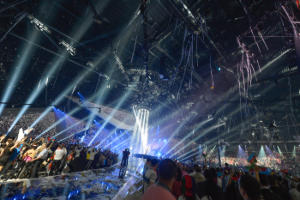Completing its 57th edition in 2012 in Baku, Azerbaijan, the annual Eurovision Song Contest has grown to an event which is broadcast live around the globe to an audience of millions. Using the latest in High Definition video and audio technology makes the audio, lighting and communication design on site an ever growing challenge, too. As recording and mixing of a full orchestra became obsolete since only the lead vocals of the songs must be performed live from 1998, advanced monitoring and communcation while delivering clear audio for the tv stream and recording as well as to all areas in the venue without interferences still require highly advanced technology and design. Cutting edge tv broadcast also calls for direct camera view from almost any position inside the venue to any position on stage, in the audience or backstage, demanding lowest possible profile of all gear.
In 2012 the contest was held at The Baku Crystal Hall, a brand new multi-purpose indoor arena with a capacity of 23.000 spectators. The Baku Crystal Hall was commissioned by the City of Baku specifically for this event and construction was completed in a mere eight months. Baku hosted 42 participating countries spanning three live broadcasts. The 2012 Finals had a live viewing audience of 23.000 plus an estimated 125 million television and internet viewers worldwide, making it the largest music television program in the world.
Toneheads GmbH of Cologne, Germany supplied all audio equipment and technical support for Eurovision, under the leadership of Florian Kessler. Toneheads also supplied all microphones and in-ear transmitters and receivers for all of the performers.
Toneheads has an experienced professional employee pool and the latest audio solutions for film and TV production, concerts, shows, fairs, galas, concerts, meetings, conferences, fixed installations, and Dry hire sale. Toneheads regularly work with Cape Cross, who supplied all the lighting and rigging for Eurovision.
 The design of the arena sound was fairly straightforward, with a few challenges along the way. The team had to evenly distribute audio to all parts of the arena, with Eurovision being the very first event in the new venue. "We were also dealing with a low trim height – only 16 metres. That posed some design challenges as well," said Kessler. Actually, Toneheads did a perfect job in placing the speaker systems almost invisible. If you click on the photo, it will open a zoom with some of the L-Acoustics arrays marked by a circle. The design of the arena sound was fairly straightforward, with a few challenges along the way. The team had to evenly distribute audio to all parts of the arena, with Eurovision being the very first event in the new venue. "We were also dealing with a low trim height – only 16 metres. That posed some design challenges as well," said Kessler. Actually, Toneheads did a perfect job in placing the speaker systems almost invisible. If you click on the photo, it will open a zoom with some of the L-Acoustics arrays marked by a circle.
"Due to the low trim height we had to use small PA-Systems because of the viewing axis of the camera systems – especially the flown camera systems. With the L-Acoustics Kiva and Kara Systems we made the right choice and had good discussions about PA Sizes. We split the PA Systems into three main circles. The first was built with eight L-Acoustics Kiva Systems each with two Kilo and eight Kiva flown around the outer stage frame. To get a good coverage at the height of the Crystal Hall we built the second circle with five L-Acoustics Kara positions each with three SB18 in cardioid mode and nine Kara-Systems. The third circle consisted of 11 Kara positions flown around the grandstand. These positions were also three SB18 and nine Kara Systems. Another two positions of Kara were used to cover the greenroom and another two as outfills for the areas around the greenroom. For the conventional monitoring we used six L-Acoustics 112XT and two Kiva Arrays (each two Kilo and eight Kiva) flown at the stage," Florian explained.
"In preparation of the sound concept we talked a lot with the Broadcast Sound Engineers to get optimal athmomicrophone–positions. Due to our rigging positions of the first circle they had the chance to get microphone positions behind the PA System. It worked really well. Markus Müller Communication was assigned from Sennheiser to execute the part of the complete wireless microphones and In-Ear monitoring. Three of our wireless-technicians supported the team of Markus Müller."
"Another challenge was the unknown venue. It was the first event in the new Crystal Hall and as we arrived it was still under construction. To design our setups we got construction plans of the Crystal Hall and later some of us did a forward inspection to check technical details and make some pictures to finalize the planning."
Other gear used at the Song Contest in Baku included eight Soundcraft VI6 digital mixing consoles, an Allen & Heath iLive R72 with IDR 16 - 1, two Yamaha Y 01Vi 96 consoles, one Yamaha DM2000 mixer, two Yamaha DME64 audio processors, five APC USV Smart UPS 1500 power supply backup units, several active FAR Audio loudspeakers, 24 Yamaha MSP 5 powered loudspeakers, 72 channels Sennheiser Wireless 5000er Series, 65 handheld microphone/capsule combinations Sennheiser SKM5200 with Neumann KK104 capsule, 110 Sennheiser HSP-4 headset microphones, 36 Sennheiser SR2050 in-ear transmitters, 168 Sennheiser EK2000 in-ear receivers, 380 Sennheiser IE60 earphones, kilometers of analogue and digital multicore cables, conventional and fibre optic network cables, speaker cables, and loads of accesories like stands and rigging accessories. |
|